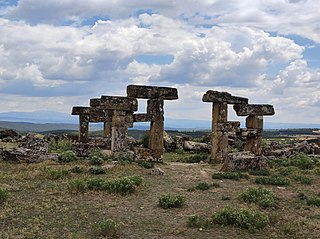Related Research Articles
Bigadiç is a town and district of Balıkesir Province in the Marmara region of Turkey. As former Ancient bishopric of Achyraus, it remains a Latin Catholic titular see.
Berissa, also spelled Berisa, Verisa, or Verissa, was a city in the late Roman province of Pontus Polemoniacus, in Asia Minor, which Kiepert and W. M. Ramsay have identified with the modern village of Baulus, 25 kilometres south-west of Tokat.
Germanicopolis was an ancient town in Bithynia, also known as Caesarea in Bythinia (not to be confused with Caesarea Germanica, as such a former bishopric and present Latin Catholic titular see.
Cotenna or Kotenna was a city in the Roman province of Pamphylia I in Asia Minor. It corresponds to modern Gödene, near Konya, Turkey.

Citharizum was a town and fortress on the south arm of the Euphrates in the Roman province of Armenia III. It was a place of great strength which was built by the emperor Justinian and was the residence of one of the five prefects whom that emperor placed over Roman Armenia with the title of “Dux.”
Cestrus was a city in the Roman province of Isauria, in Asia Minor. Its placing within Isauria is given by Hierocles, Georgius Cyprius, and Parthey's. While recognizing what the ancient sources said, Le Quien supposed that the town, whose site has not been identified, took its name from the River Cestros and was thus in Pamphylia. Following Lequien's hypothesis, the 19th-century annual publication Gerarchia cattolica identified the town with "Ak-Sou", which Sophrone Pétridès called an odd mistake, since this is the name of the River Cestros, not of a city.
Dalisandus or Dalisandos was a city of ancient Cappadocia and later of Isauria, near the river Cydnus. It is considered to have been near Sınabiç, 6 km north of Claudiopolis, Turkey.
The city of Blaundus was the seat of a bishopric in the Roman and Byzantine era. It was a suffragan of the Metropolitan Archdiocese of Sardes, also in Lydia. It was part of the Patriarchate of Constantinople and was suffragan of Archdiocese of Sardis.
Zygris was a small town in the Roman province of Marmarica, a province also known as Libya Inferior. It was in the eastern part of this region, which some geographers considered a separate area, called Libycus Nomus, distinct from both Marmarica and Aegyptus. It may have been located at Zaviet-El-Chammas in modern Egypt. Diderot's Encyclopedia gave Solonet as its modern name.
Comba or Komba was a city in ancient Lycia.

Blaundus was a Greek city founded during the Hellenistic period in Asia Minor, presently Anatolia, and is now a Latin Catholic titular bishopric.
Gabula was an ancient city and former bishopric in Roman Syria, and remains a Latin Catholic titular see.
Euaza, located in what is modern Turkey was a town during the Hellenic, Roman and Byzantine era. The town was in the upper portion of the Cayster River valley, about 100 km east from Ephesus. The town also known as Augaza, appears in Notitiea episcipum of the 9th century. The area is still mainly agricultural.
Boreum was a city and diocese in Roman Libya. It is now a Roman Catholic titular see.
Claneus or Klaneos or Klaneous was an ancient city and bishopric in Asia Minor.
Vasada was a city of ancient Lycaonia and later of Isauria, Asia Minor. It was located a little to the southwest of Laodiceia. In the acta of church councils attended by its bishop, the name appears variously as Usada or Ousada (Οὔσαδα) or Aasada (Ἀάσαδα).
Andropolis was an Ancient city and former bishopric in Roman Egypt, and is now a Latin Catholic titular see.

The Diocese of Zagylis is the titular diocese of the Roman Catholic Church, established in 1933 by Pope Pius XI, named after the ancient city of Zagylis in present-day Libya.

The Diocese of Antiphrae is a Roman Catholic titular see and was an ancient diocese.
Ciscissus or Kiskisos was a town and bishopric of ancient Cappadocia. In Roman and Byzantine times the town's name was sometimes shortened to Cissus and belonged to the Roman province of Cappadocia Prima. It became a Christian bishopric, a suffragan of the metropolitan see of Caesarea in Cappadocia, the capital of the province. The names of two of its bishops are known from extant contemporary documents: Plato was at the Trullan Council of 692, and Soterichus at the Second Council of Nicaea in 787. No longer a residential bishopric, Ciscissus is today listed by the Catholic Church as a titular see.
References
- ↑ Pius Bonifacius Gams, Series episcoporum Ecclesiae Catholicae, (Leipzig, 1931), p. 462.
- ↑ Michel Le Quien, Oriens christianus in quatuor Patriarchatus digestus, (Paris, 1740), Tomo II, coll. 629-630.
- ↑ Raymond Janin, v. Dysthis in Dictionnaire d'Histoire et de Géographie ecclésiastiques, vol. XIV, (Paris, 1960), col. 1252.
- ↑ Entry at www.gcatholic.org.
- ↑ David Cheney, Diocese of Dysti, at Catholic-Hierarchy.org.